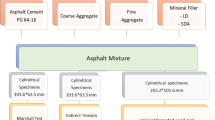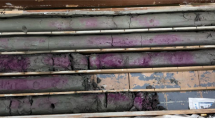Abstract
Used Cooking Oil (UCO) that mixes with soils can weaken its engineering properties. This paper investigates stabilizing UCO-contaminated fine sand natural soil to be used as subgrade layer in road pavement structures. Xanthan gum is utilized as the stabilizing material. Stabilization is evaluated in terms of the soil’s California Bearing Ratio (CBR). It is found that the increase in Xanthan gum content (Xc) enhances the CBR value of UCO-contaminated fine sand soils. Generally, results indicated that at any Xc value between 0.1 and 0.9%, UCO-contaminated fine sand soil samples with lower CC values have higher CBR. The effective content of Xanthan gum powder to enhance the soil’s CBR value is found to be 0.4%. Considering Xcof 0.4% and UCO contamination content (CC) of 0.2%, it is indicated that the soil’s CBR value increases by 304% and 149.4% of the CBR value of natural sand soil and UCO-contaminated sand soil in order. In addition, Xc of 0.9% updates the unconfined compressive strength to 10.1 kPa and 7.6 kPa for soil samples with CC = 2% and 8%, respectively. Durability study shows that wet and dry cycles decrease the CBR of fine sand stabilized soil. The trend of CBR reduction in wet cycles is higher than that of dry cycles. Economically, stabilizing UCO-contaminated fine sand soil reduces the required pavement thickness by about 11.3%. On the other hand, the paper introduces a contour map and general mathematical model to estimate the CBR value of in terms of Xc and CC.















Similar content being viewed by others
References
Shalaby EA, El-gendy NS (2012) Two steps alkaline transesterification of waste cooking oil and quality assessment of produced biodiesel. Int J Chem Biochem Sci 1:30–35
Ibrahim A, El-kassaby MM (2013) An experimental evaluation of using waste cooking oil biodiesel in a diesel engine. Energy Technol 1:726–734. https://doi.org/10.1002/ente.201300100
World S-S (2017) Converting cooking oil to biodiesel. https://www.southsouthworld.org/component/k2/46-solution/1006/converting-cooking-oil-to-biodiesel
Gobinath GPGR, Kovendiran IIAS (2017) Bio-enzymatic stabilization of a soil having poor engineering properties. Int J Civil Eng 15:401–409. https://doi.org/10.1007/s40999-016-0056-8
Asgari MR, Dezfuli AB, Bayat M (2015) Experimental study on stabilization of a low plasticity clayey soil with cement/lime. Arabian J Geosci 8:1439–1452. https://doi.org/10.1007/s12517-013-1173-1
Onyelowe K, Van DB (2018) Predicting subgrade stiffness of nanostructured Palm bunch ash stabilized lateritic soil for Transport geotechnics purposes. J GeoEng. https://doi.org/10.6310/jog.2018.13(1).3
Okonkwo O, Nwokike M (2015) Soil-cement stabilization for road pavement using soils obtained from Agu-Awka in Anambra state. J Multidiscip Eng Sci Technol (JMEST) 2(10):2668–2670
Rao SM, Reddy BVV, Muttharam M (2001) The impact of cyclic wetting and drying on the swelling behaviour of stabilized expansive soils. Eng Geol 60:223–233
Al-rawas AA, Hago AW, Al-sarmi H (2005) Effect of lime, cement and Sarooj (artificial pozzolan) on the swelling potential of an expansive soil from Oman. Build Environ 40:681–687. https://doi.org/10.1016/j.buildenv.2004.08.028
Kalkan E (2006) Utilization of red mud as a stabilization material for the preparation of clay liners. Eng Geol 87:220–229. https://doi.org/10.1016/j.enggeo.2006.07.002
Guney Y, Sari D, Cetin M, Tuncan M (2007) Impact of cyclic wetting: drying on swelling behavior of lime-stabilized soil. Build Environ 42:681–688. https://doi.org/10.1016/j.buildenv.2005.10.035
Segetin M, Krishnan J, Xu X (2007) Effect of lime, cement and Sarooj (artificial pozzolan) on the swelling potential of an expansive soil from Oman. Build Environ 42:3066–3079. https://doi.org/10.1016/j.buildenv.2006.07.033
Sunitsakul J, Sawatparnich A (2012) Prediction of unconfined compressive strength of soil: cement at 7 days. Geotech Geol Eng 30:263–268. https://doi.org/10.1007/s10706-011-9460-7
Yilmaz Y, Ozaydin V (2013) Compaction and shear strength characteristics of colemanite ore waste modified active belite cement stabilized high plasticity soils. Eng Geol 155:45–53. https://doi.org/10.1016/j.enggeo.2013.01.003
Abo I, Naga E, Elsiragy MN, Ragab M (2020) Utilization of synthetic reinforcement for enhancement of oil-contaminated subgrade soil in highway pavement. Innov Infrastruct Solut 5:1–10. https://doi.org/10.1007/s41062-020-00289-9
Pritam S, Iyer KK (2020) Effect of stabilization on characteristics of subgrade soil: a review. Adv Comput Methods Geomech 55:667–682. https://doi.org/10.1007/978-981-15-0886-8_54
Ayeldeen MK, Negm AM, El-Sawwaf MA (2016) Evaluating the physical characteristics of biopolymer/soil mixtures. Arabian J Geosci 9:1–13. https://doi.org/10.1007/s12517-016-2366-1
Glassner DA, Gruber PR, Vink ETH, Ra KR (2003) Applications of life cycle assessment to NatureWorks TM polylactide (PLA) production. Polym Degrad Stab 80:403–419. https://doi.org/10.1016/S0141-3910(02)00372-5
Ayeldeen M, Negm A, El-Sawwaf M et al (2016) Laboratory study of using biopolymer to reduce wind erosion. Int J Geotech Eng 6362:1–13. https://doi.org/10.1080/19386362.2016.1264692
Chang I, Kharis A, Im J et al (2015) Soil treatment using microbial biopolymers for anti-desertification purposes. Geoderma 253–254:39–47. https://doi.org/10.1016/j.geoderma.2015.04.006
Chang I, Im J, Kharis A, Cho G (2015) Effects of Xanthan gum biopolymer on soil strengthening. Constr Build Mater 74:65–72. https://doi.org/10.1016/j.conbuildmat.2014.10.026
Khachatoorian R, Petrisor IG, Kwan CC, Yen TF (2003) Biopolymer plugging effect: laboratory-pressurized pumping flow studies. J Pet Sci Eng 38:13–21
Dejong JT, Soga K, Kavazanjian E, Burns S (2013) Biogeochemical processes and geotechnical applications: progress, opportunities and challenges. Geotechnique 63:287–301
Nasr AMA (2014) Utilisation of oil-contaminated sand stabilised with cement kiln dust in the construction of rural roads. Int J Pavement Eng 15:889–905. https://doi.org/10.1080/10298436.2014.893321
Shah SJ, Shroff AV, Patel JV et al (2003) Stabilization of fuel oil contaminated soil: a case study. Geotech Geol Eng 21:415–427
Akinwumi II, Booth CA, Diwa D, Mills P (2016) Cement stabilisation of crude-oil-contaminated soil. Proc Inst Civil Eng 169:336–345
Ojuri OO, Epe GG (2016) Strength and leaching characteristics of crude oil contaminated sandy soil stabilized with Sawdust ash-cement. Geo-Chicago 2016:582–590
American Society of Testing Materials ASTM D1557, D3080, and D1883 - Annual book of ASTM standards
Choi Y, Ahn D, Lee Y, Ahn J (2020) Compaction quality monitoring of open-graded aggregates by light weight deflectometer and soil stiffness gauge. Sustainability 12:2521. https://doi.org/10.3390/su12062521
Rosalam S, England R (2006) Review of xanthan gum production from unmodified starches by Xanthomonas comprestris sp. Enzyme Microb Technol 39:197–207. https://doi.org/10.1016/j.enzmictec.2005.10.019
Comba S, Sethi R (2009) Stabilization of highly concentrated suspensions of iron nanoparticles using shear-thinning gels of xanthan gum. Water Res 43:3717–3726. https://doi.org/10.1016/j.watres.2009.05.046
Changa I, Prasidhic K, Imb J, Chob GC (2015) Effects of Xanthan gum biopolymer on soil strengthening. Constr Build Mater 74:65–72. https://doi.org/10.1016/j.conbuildmat.2014.10.026
Chen C, Wu L, Perdjon M et al (2019) The drying effect on xanthan gum biopolymer treated sandy soil shear strength. Constr Build Mater 197:271–279. https://doi.org/10.1016/j.conbuildmat.2018.11.120
Laneuville S, Turgeon S, Sanchez C, Paquin P (2006) Gelation of native β-Lactoglobulin induced by electrostatic attractive interaction with Xanthan Gum. Langmuir 22:7351–7357
Bobade V, Cheetham M, Hashim J, Eshtiaghi N (2018) Influence of gas injection on viscous and viscoelastic properties of Xanthan gum. Water Res 134:86–91. https://doi.org/10.1016/j.watres.2018.01.071
Rostami R, Ebrahimabadi A, Bakhshandeh M (2017) Using graphite nanoparticles for optimum design of water-based drilling fluid (Case study: Azadegan oil field) using graphite nanoparticles for optimum design of water-based drilling fluid (Case Study: Azadegan Oil Field). EurAsian J BioSci 11:16–21
Palaniraj A, Jayaraman V (2011) Production, recovery and applications of xanthan gum by Xanthomonas campestris. J Food Eng 106:1–12. https://doi.org/10.1016/j.jfoodeng.2011.03.035
Cabalar AF, Wiszniewski M, Skutnik Z (2017) Effects of xanthan gum biopolymer on the permeability, odometer, unconfined compressive and triaxial shear behavior of a sand. Soil Mech Found Eng 54:356–361. https://doi.org/10.1007/s11204-017-9481-1
Khodadadi MR, Malpartida I, Tsang C et al (2020) Recent advances on the catalytic conversion of waste cooking oil. Mol Catal 494:111128. https://doi.org/10.1016/j.mcat.2020.111128
Liu Y, Yu Z, Lv C et al (2020) Preparation of waste cooking oil emulsion as shrinkage reducing admixture and its potential use in high performance concrete: effect on shrinkage and mechanical properties. J Build Eng 32:101488. https://doi.org/10.1016/j.jobe.2020.101488
Ma J, Sun G, Sun D et al (2020) Rubber asphalt modified with waste cooking oil residue : Optimized preparation, rheological property, storage stability and aging characteristic. Constr Build Mater 258:120372. https://doi.org/10.1016/j.conbuildmat.2020.120372
Dong R, Zhao M, Tang N (2019) Characterization of crumb tire rubber lightly pyrolyzed in waste cooking oil and the properties of its modified bitumen. Constr Build Mater 195:10–18. https://doi.org/10.1016/j.conbuildmat.2018.11.044
Arshad M (2019) Development of a correlation between the resilient modulus and CBR value for granular blends containing natural aggregates and RAP/RCA materials. Adv Mater Sci Eng 2019:1–16
Devendra E, Joshi YP (2014) A detailed study of CBR method for flexible pavement design. Int J Eng Res Appl 4:239–253
Taskiran T (2010) Prediction of California bearing ratio (CBR) of fine grained soils by AI methods. Adv Eng Softw. https://doi.org/10.1016/j.advengsoft.2010.01.003
Doshi S, Mesdary M, Guirguis H (1983) A statistical study of laboratory CBR for Kuwaiti soils. In: Road engineering association of Asia and Australasia
American Society of Testing Materials (2000) ASTM D1633–00 annual book of ASTM standards section four: construction
Tingle JS, Santoni RL (1819) Stabilization of clay soils with nontraditional additives. Transp Res Record. https://doi.org/10.3141/1819b-10
Azzam WR (2014) Durability of expansive soil using advanced. Int J Geomate 7:927–937
Solanki P, Zaman M (2014) Effect of wet-dry cycling on the mechanical properties of stabilized subgrade soils. In: Geo-congress 2014: geo-characterization and modeling for sustainability, p 3625–3634
Beriha B, Biswal DR, Sahoo UC (2018) Effect of wet-dry cycles on mechanical strength properties of cement stabilized granular lateritic soil. In: GeoMEast
Author information
Authors and Affiliations
Corresponding author
Ethics declarations
Conflict of interest
The authors declare that they have no conflict of interest.
Informed consent
Informed consent was obtained from all individual participants included in the study.
Rights and permissions
About this article
Cite this article
Elkafoury, A., Azzam, W. Utilize Xanthan gum for enhancing CBR value of used cooking oil-contaminated fine sand subgrade soil for pavement structures. Innov. Infrastruct. Solut. 6, 25 (2021). https://doi.org/10.1007/s41062-020-00389-6
Received:
Accepted:
Published:
DOI: https://doi.org/10.1007/s41062-020-00389-6




